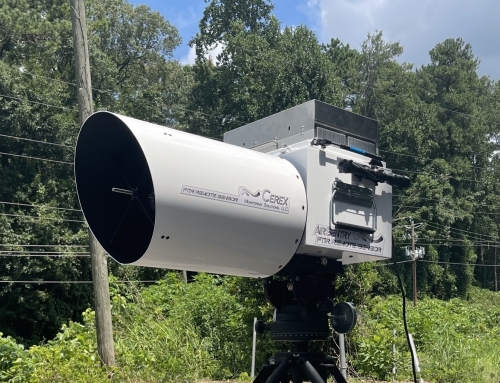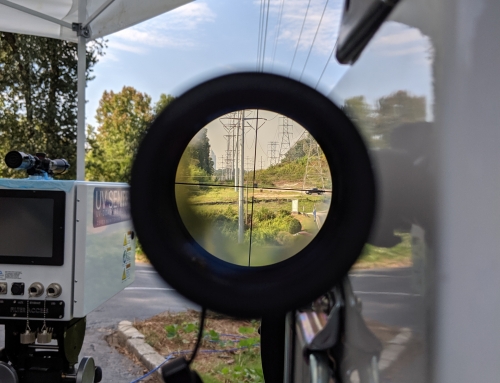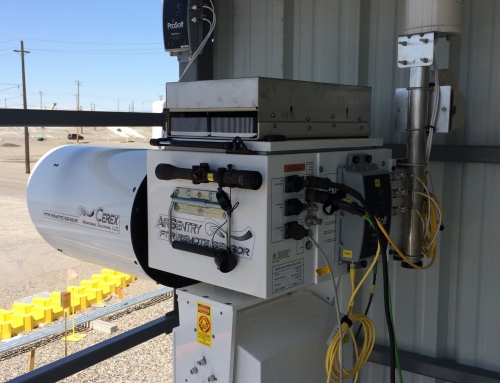Reported Concentrations
The Open Path Fourier Transform InfraRed (OP-FTIR) gas analyzer detects gas clouds which cross an infrared light beam path. The Cerex OP-FTIR projects an infrared beam to a retroreflector (a specialized reflective device) to detect gases. Gas clouds detectable by the OP-FTIR absorb the infrared light beam. The amount of absorption is based on the width of the gas cloud times the concentration of the gas cloud intersecting the infrared light beam (see Figure 1 – A cloud crossing an OP-FTIR beam with ppb*m figure). The OP-FTIR detects gas clouds with units of part per billion meter (ppb*m) or the product of concentration and gas cloud width. The combination of concentration and gas cloud width is called a path integrated concentration. The Cerex OP-FTIR reports gas concentration in units of part per billion (ppb); the reported concentration is based on an assumption that the gas cloud is present in a uniform distribution along the entire infrared light beam (see Figure 2 – Reality (Figure 1)
vs what the instrument assumes it sees; maybe cross-section view).
The OP-FTIR cannot determine the actual width of the gas cloud or where in the infrared light beam the gas cloud is. If the OP-FTIR reported concentration is combined with gas plume modeling software the gas cloud width, gas cloud location, and gas cloud concentration may be determined (see Figure 3 – Add wind vectors and cloud dispersion gradient, overlaid with actual cloud, and showing measurable dimensions). To obtain the reported concentration, the path integrated concentration detected by the OP-FTIR is divided by the infrared light beam path length (see Equation x). For normal measurements the path length distance is typically twice the distance between the OP-FTIR and the retroreflector – the light beam travels there and back. To recap:

The OP-FTIR detects path integrated concentrations of gas (ppb*m)
Reported concentrations in ppb have been divided by a path length in meters (ppb*m/m=ppb)
The path length is typically twice the distance between the OP-FTIR and the retroreflector in meters
The reported concentration in ppb assumes a uniform concentration distribution along the entire path length
The path length used to divide the path integrated concentration does not have to be twice the distance between the OP-FTIR and the retroreflector
The path length can be a value of 2 to report a normalized ppb*m
This accounts for the infrared light beam travelling through the gas cloud twice – once on the way to the retroreflector and once after being reflected
The path length may be twice the optical length of a test gas cell
The Cerex OP-FTIR includes an internal flow through test gas cell with an optical length of 0.075m for a path length of 0.15m
The path length may be arbitrary; however, the reported concentrations will also be arbitrary
The path length used to compute the reported concentration is the distance in meters entered into the Cerex OP-FTIR software configuration.
When performing OP-FTIR tests or audits, understanding the relationship between path integrated concentration, test gas cylinder concentration, the path length entered into the OP-FTIR’s software configuration, and the test cell’s path length is critical. Failure to understand this relationship may result in unexpected reported concentrations which are vastly different than the cylinder gas concentration label; however, the results may still be accurate. To help with this concept please refer to the following example:
An OP-FTIR is installed with a retroreflector 154 meters away. The path length in OP-FTIR software configuration has been set to 308 meters. An operator wishing to perform an audit has purchased a cylinder containing 100ppm of ammonia gas. Without changing any software settings or hardware configuration, the operator flows the 100ppm ammonia gas into the internal 0.15-meter path length flow through cell. The reported concentration is 48.701ppb. Why is the reported concentration 48.701ppb instead of 100ppm?
OP-FTIR to retroreflector physical separation=d=154m
OP-FTIR optical path length=l_1=2d=2*154m=308m
Software configuration path length=L=308m
OP-FTIR internal flow through cell path length=l_2=0.15m
Ammonia test gas concentration=C=100ppm=100000ppb
Detected path integrated concentration=C*l=100,000ppb*0.15m=15000ppb*m
The 0.15m length is used because the gas only fills the flow through cell – 0.15m of the infrared light beam path.
Reported concentration=(C*l)/L= (15000ppb*m)/308m=48.701ppb
The reported concentration is 48.701ppb because the path integrated concentration is being divided by the path length value set in the OP-FTIR software. If this value is changed, the reported concentration will also change:
If the software configuration path length is set to=L=0.15m
Reported concentration=(C*l)/L= (15000ppb*m)/0.15m=100000ppb
Reported concentration=100000ppb* 1ppm/1000ppb=100ppm
By changing the OP-FTIR software configuration’s path length to match the test cell’s path length the reported concentration will match the audit gas’s concentration.








